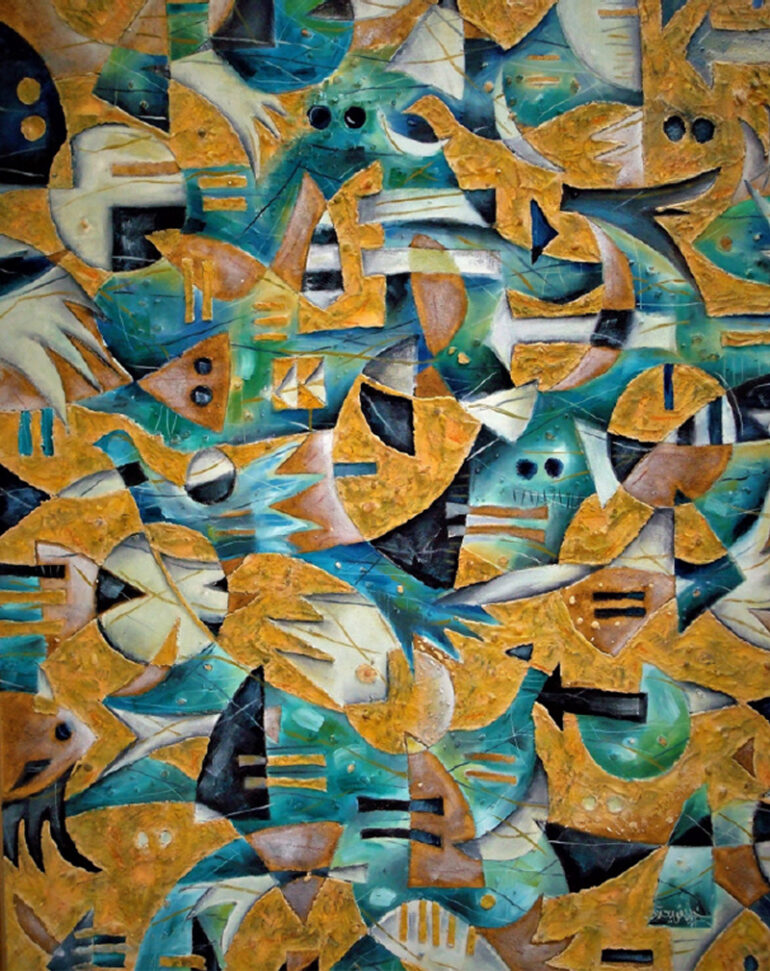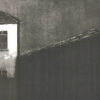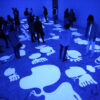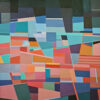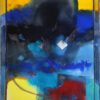Investigations between Words and Deeds
A study on the problematic art terminology in the visual arts field
The fluctuations witnessed in the artistic and aesthetical concept reflect the changes taking place in the forms of existence within human societies… Through my book (L’Art à l’état gazeux “Art in its gaseous state”), I do not only raise a topic that is related to art, but I propose an interpretation of the evolution that our society is experiencing
Yves Michaud
Abstract:
This article seeks to address conceptual transformations, related to visual arts, in the light of the aesthetic and critical discourses formulated between modern and contemporary art and its impact on the evolution of the artistic term. It addresses the cultural stand that must be taken in formulating the artistic term in the Arabic language in order to resume the creative approach.
As for the suggestions at the end of the article, it concerns the state of the art concept in its translation between Arabic and other languages. Through a sample that is daily used, yet shrouded in mystery. In this regard, victory belongs to the creative and historical approach, as it is not sufficient to only translate, but rather it requires our contribution to the creative accumulation and participation in the civilizational and existential battle that we must engage in through art.
Keywords: concept, labeling, identification, artifact, language.
Undoubtedly, verbal discourse -in the tradition of contemporary art- is a part of the creative process itself, not just a media trick or an isolated cultural fabrication. Rather, the act of perceiving an artwork inherently requires the act of saying within the tools of conceptualization, interpretation and discourse making… This shines through the works of American analytical philosophy, which focused on studying works of art and formulated the philosophy of contemporary art, where we can see that it is clearly based on Wittgenstein’s philosophy, it extended the connections between logic and aesthetics, so how do we express the artistic experience? And with what tools? When the verbal language has come to rationalize our understanding of art and define our interaction with the artwork, how can saying be an actual foundation of the nature of artwork? In the face of this situation, can we simply translate the concept and terminology so that we keep pace with the shifts of artistic values and contribute to their accumulation, so we continue to gasp behind the emerging concepts that are in fact the daughters of value crises and historical setbacks that their creators have experienced?
Can translation absorb this level of conflict to be a solution to this paradox? In this case, we can’t help but wonder whether this artist, when facing a crossroad, will be preoccupied with searching for appropriate translations, or will he create and move within a new, unconsumed creative horizon, outside the available lingual map and what is there in translated writings! Shall we translate or create? And with what set of concepts and terms does this artist express himself or affirms his new creative artwork what it deserves from artistic identification elements? That is the predicament that calls us today, more than ever, to question the topic of “the challenge of translation and the challenge of creativity”
The artwork in various eras of aesthetics was limited to the question of “how do I create it?”, whereas today it highly corresponds to “How do I present what was created?” And “How do I say what I present?” which shifted the centers of attention to the process of art getting created while watching and how it is lured into theory. As for dematerialization, it pushed the matter to broad intellectual conquests, which led to a linguistic-conceptual presence of the artwork. Where the creation of artwork within theory flourished, and the reconciliation of art with the understanding mind and linguistic rationality was strengthened. The utilization of the conceptual and interpretive tools also led to opening important horizons for the participation of the recipient and the critic in fertilizing meaning, accumulating and producing values and ideas in concepts and terms. This has even stimulated transformative capabilities, where it created a smooth transition from image to conceptualizing and from form to issue. That’s when the concept became what makes the artwork! And to the same extent, the subjective destruction of the core effect and the ruling ego did not occur, even in the heart of the aesthetics most closely related to the daily collective and relational matters. Moreover, the forgotten core of the concept aesthetic lies in the “I-conceptualize” or “I-understand”, which enriched the reasoning of the world through verbal discourse. So is it enough to translate the conceptual system while it’s moving constantly within this transformative context from modern to contemporary art that we can actually participate in its accumulation, or at least when the geopolitical map does not allow artistic promotion, is it enough to translate in order to understand and read?! What is the position of the Arab artist in this realm and with what conceptual arsenal can he create an effective presence?
Investigations in Term and Concept Translation
Many are the artistic terms and concepts that we deal with on a daily basis in our Arab world, both in academic research circles and in cultural and media fields, but most of them are surrounded by

vagueness. On one hand, this came from the fact that it no longer truly conveys what we mean, and has been long passed by artistic practices, and on the other hand, it is a superficial translation of content that is immersed in specification, or it is epistemically incompatible with the nature of the subjects we address through it. At this level, we may weave discourses with Platonic concepts steeped in idealism, around works of contemporary art that herald radical value transformations and rebel against the old conceptual heritage, in which its historical value is manifested, or even derives its specificity. This confirms, on one hand, that the translation movement does not keep pace with these accelerated conceptual shifts or, at the very least, does not introduce appropriate non-controversial translations we can agree on, as it does in the medical sciences… On the other hand, the predominant absence, or the modest presence, of Arab experiences in accumulating or contributing to such shifts may be an excuse for lowering the need for the Arabic linguistics to engage in the understanding and participate in the creation of the concept and enable it to have a widespread life. As a result, we continue to engage with contemporary art as a form that is separate from its specific contents, such as the contents of rejection, irony, criticism, protest, sensitization, and other types of content that resulted from the historical situations that are closely related to the social circles in which they arose. Thus, in our dealings with contemporary as well as modern artwork, we either limit ourselves to sensory stimuli without the mental ones that are translated by the conceptual language, or the other way around, so our view of artworks remains amputated or one-sided, which hinders the processes of receiving and reading…
If language was a sense of belonging,
would we be able to relate to the contemporary art world
with our Arabic language?
On this basis, our need for improving the critical dictionary becomes greater with the evolution of visions, methods, and situations. And if the inherited dictionaries are unable to carve out vocabulary from their inventory to keep pace with the ticks of times, it is futile to hope for flawed translations that come from limited prospects to compensate for this deficit. How will we ever be able to set the translation straight while the modalities in our linguistics are yet to be found! Therefore, the language should be flexible, open, and prepared to upgrade its vocabulary to keep up with the evolution of concepts among its speakers, or else, how do we explain the migration of creative minds to linguistic universes other than the ones in which they grew up so they can express themselves! And the crisis may extend to involve the tendency to read our arts in a language other than our own, such as reading the geometric, mystical, and moral thinking of arabesque in English, and the problem is not only to acquiesce to the most authoritative language (that is another side of the issue) but also because the original and ancient terminological universe becomes elusive to most of its audience and no longer achieves the desired level of communication. So how can we express the unity of existence in the concept of “collective familiarity”, as Al-Mawardi described it in his book “The Literature of the World and Religion”, whether in the art of ornamental engraving or in a manuscript made in Thuluth font! Applying moral and value concepts such as “familiarity”, “intimacy” and “altruism” will lead the engraved piece in front of us, with its soft colors, to be a cluster of mystical, moral, and religious values that are based on monotheism and the act of “praise” only, without being able to extrapolate its power in glorifying life itself. Why hasn’t Arabic produced enough terminology to understand the Arab visual arts? For how long will the tongue stand powerless in face of what we perceive, and for how long can we keep dumbing the burden on insight rather than the sight? And then, what fate will our alienated floral and Astro vocabularies face when we have the capacity to program and code our vocabulary system into computer software? Will we process them in a programing language or shall we come up with modern aesthetical vocabularies derived from modern and contemporary arts?
If art was humane, in this very time, claiming to be universal
under the umbrella of “contemporary art”, how can we engage in it
with a language that doesn’t own this universality feature art claims to have?
If we treat Arabesque رقيشة only as an imagery element “imagerie”, it certainly won’t be fair to them, because it will become no more than an individual traditional industry, the proportion of innovation and creative intelligence in it is much higher than the proportion of copying and imitation, it is closer to what we call “traditional industries” that fine artists contribute to developing, and imitation is certainly not what they seek! And if we treat it as an art on its own that is closer to major art or “Arts majeurs”, then how could we explain its connection to the functional purpose? It is an engraving on a door, a ceiling, a wall, a piece of furniture, or an element of architecture, no matter how precise the efforts of the veteran artists to make it a sight to behold, and it is not an artistic entity isolated from functionality. It might seem as if it’s an artwork on its own, but this fallacy comes from the intentionality of the beholder. It is in its creation purpose a door, a window, or a mihra… The presence of Arab artists appears to be ambiguous in the absence of a signature. If names are mentioned, it is no more than a mention of the engineers who designed and ordered the construction, ministers and sultans, as they are the reason to create this palace or mosque in the first place… The absence of the artistic term in the Arabic arts is only a continuation of the absence of the artist himself as a creative entity that tends to be independent. And only on his independence, the conceptual universe of his art becomes visible. Art in the history of Arabic theory is ornamenting, varnishing, and imitating, it does not exceed what Ibn Rushd calls the “الزواقة”, which is an imitation of nature like “Depiction”
The features of terminology crisis are almost limited to the critical discourse presented in Arabic, which did not construct a terminology in which modern and contemporary creative values can be dealt with. Meanwhile, researchers continue to face what is new either with old terms imbued with Platonic metaphysics or translated in a general lexical way.
We are still dealing with the concept of “esthétique” in terms of “what is beautiful”, which brings us back to the idea that beauty represents the essence of every artistic creation. Once again, the mind is implicated in the fallacy that art is beautification, retouching and improvement, as the term confuses the artist (who is supposed to come up with new values and may rebel against the prevailing taste values) and beautification artisans…
While the German Baumgarten meant by the word “aistheta” the emotional and sensory forces of man, (the equivalent of the word “noeta”) which means mental and geometrical forces, in order to challenge what the German philosopher Leibniz proposed; that emotions, sentiments, and feelings do not rise to knowledge. Aesthetics is sensibility in itself, and it is a “general theory of sensation.” This paradox’s risky aspect becomes apparent when we translate the concept of «l’esthétique du laid» to “ugly’s aesthetics”!
On the other hand, we’re still dealing with depiction art as if it is “painting” or “oil painting” to talk about the work of Georges Mathieu, the French lyrical artist! This limits how we view painting as it is a geometric process revolving around the point, the line, and the area, where the thinking precedes the doing, meaning that the example precedes the reality, and it moves away from it to become a source for it, and while reality is subjected to right and wrong, so it is right as long as it is connected to its example in the mind, in emanationism, or in the ideals. Even at schools, fine arts classes are still subjected to this platonic conceptual system, as you have to draw precisely then color what we drew while considering our lines without crossing them…
We also talk about an “Arabesque رقيشة” the same way we talk about a visual work of art for Victor Vasarely, the Hungarian artist, or a painting for Néjib Belkhodja, the Tunisian artist. We use the pair “The void and the plein – الفارغ والملآن” which is a literal translation from French «le vide et le plein», we might even mention it in plural so we say “فراغات”, but in Arabic, void is not countable so it can’t be plural, unlike other languages that might objectify emptiness and nothingness.
We could have re-established the term to align with the semantic being in the Arab culture. Void and Plein enjoy a meaningful presence in the old writings, Ibn Sina as an example, author of “al-Shifa’ – The Cure” and “al-Najat – The Salvation”, in Physics and Metaphysics, and in “the Substance of Bodies” and their constitution… A void in a painting is like a hole in a sculpture, it is not exactly void or emptiness, it acts as if it is plein and a compositional element through which shapes can breathe, as it is with aquarelles.
The whiteness of a paper is a functional element for the balance of the structure. This means, it is void or empty, as in the absence of a shape or a visual density, not like in physics where it is the absence of a matter. The physical vacuum, which is a space devoid of matter, until this day, is still a mental assumption. What is void of all bodies was considered an illusion and an abstract back in the times, and it is one of the secrets of modern physics. However, this imagined “void” exists in the sensible world, and in fine arts, it could be the transparent crystal, the blank paper in aquarelles, or the white paint in a painting.
Here, the Void is Plein! It is sensibly Plein (air, crystal, blank paper…) but it is void of visual and artistic interventions… we might even say, since the display of “White on White” for the Russian artist Kazimir Malevich, or the paintings in The Museum of Modern Art and else, or the Rooms of Air that Yves Michaud talked about in “L’art à l’état gazeux (Art in a gaseous state)” and many other examples.1
We can also talk about the “Graphics” of Shiekh Mahmoud Al Feriani, so we translate the term «la peinture sous verre» into “Painting on Glass”, disregarding the conceptual background based on which the term was formed. The French term expresses what the recipient – observers – sees in the exhibition, while the Arabic term expresses what the artist sees in his studio while working. Between the exhibition and the studio, under “sous” becomes on “sur”. This toxic usage, in the open and in the discreet, contributes to dismissing the display of an “artifact”, and dismissing the recipient’s role in seeing, tasting, and reading in the Arabian culture. Although the Glass “Graphics” was originally made to be displayed and sold, even inside shops and houses, it even emerged within the borders of symbolism and imaginative communication between these performed pieces and the different social classes.
On another front, the term “portrait” might present a complete obstruction for Arabic critical linguistics. It is a crucial representation of how the Arabic culture restrains from personification, and refrains from mentioning it regardless of the glowing presence of Persons in many areas such as al-Wasiti’s miniatures in Baghdad, poetry, and description and Ghazal technics… As a result of this obstruction, we rely on using the French term to talk about these materials, without translation, as if it is a completely foreign form, so we say “بورترية”! We might also resort to using two words for it “صورة شخصية”, and if we were to re-translate we would have “image personnelle” and this doesn’t express the meaning we’re aiming for. What we’re aiming for, from a general non-controversial perspective, is to say an Image of a Person. But we have to agree that “Person” here is the main expressive part, not the image. The image could be of a tree or of a bird… for that, the term should be associated with a “Person”, and with a “Personality”, as we can see in theatrics and performance art since the beginning of theatre, when the personality was a thin mask for the actor to wear, as in Sophocles the Greek work… or it could be a depth in which we can dive, with art, or with reading, or perceiving (percer/perce-voir).
The eye also has a central presence in personality. It is an important element for revealing the personality and a tool to express it, in addition to being a way to perceive it in this form of art. In Arabic, we use “شخص البصر” meaning “opened his eyes”, and we also say “شخّص” meaning “identified or recognized”… identifying and recognizing mean drawing the features, positions, shapes, and conditions, i.e. identifying what a subject has in a sensible way. Using this method, we can phrase our own verbal in a way it corresponds to its form in art expressions on one hand, and on the other, choosing what’s familiar from the lingual terms that are homogeneous or similar or close in the art forms. An example of that would be “نقيشة” and “رقيشة” so if we looked at the roots of those words “نقشَ – رقشَ – حفرَ – نسجَ – شخَص” we get the word “شخيصة” to mean “un portrait”. Similarly, we can use “حفيرة” for “une gravure” instead of “محفورة” because it only focuses on the object that has been engraved. Also, we might use “نسيجة” instead of “منسوجة” because it doesn’t reflect the work that has been done, it only shows what was woven “tissé-e”.
In this way, the owner of “شخيصة” is “شخاص – portraitiste” same as “نسّاج، حفّار، نقاش، رقاش، فنان، رسام، نحات، حدّاد”… as for “الشخيصة الذاتية”, in this aspect, it can only mean what’s meant by “autoportrai”, and what’s currently used in many academic critical writings “أوتوبورتراي”.
Conclusion
There is no doubt that art is not merely looking at something; it is looking through something, and looking is not mere monitoring or watching (regarder), it is innovating and knowing (savoir), and knowing is mainly about knowing what to say (sa-voir-dire) from within the language, otherwise, it wouldn’t have existed. However, under what circumstances does an art prosper mentally and cognitively via a set of terms and concepts, and how does it fade and perish with them? When do words kill objects and how does it become an oppressive authority over them? Is it true that enhancing the art terminology could contribute to sorting out the relations between “words and objects” in a way it could determine how we can particularly perceive the essence of the art? Moreover, if language is a system of rules, regulations, and ways of saying; then the artwork would continue to be incomprehensible to this system, it would be “above the law” as Paul Klee stated!
More so, if language was a sense of belonging, would we be able to relate to the contemporary art world with our Arabic language? If art was humane, in this very time, claiming to be universal under the umbrella of “contemporary art”, how can we engage in it with a language that doesn’t own this universality feature art claims to have? How is the Tunisian artist struggling today with a tragic and problematic existence, when he’s roaming around with a map claiming to be universal with meta-local concepts and terms, and at the same time, he’s actively going where his limited lingual map allows him to be, even though it contains a rich socio-logical reserve.
1. Of those we mention two artworks at The Centre Pompidou, Paris, Contemporary Art Section. The first one is for Jo Baer “Untitled”, 1963, oily paint “white” on canvas. The second is for Robert Ryman “Untitled”, 1974, laqué on canvas.
Prof. Khélil GOUIA holds a Ph.D. in Art sciences and Techniques/ specializing in contemporary art, hes is a researcher, artist, & Professor of art theories and semiology at the University of Sfax, Tunisia. He is awarded Shiekh Zayed Book Awards, Abu Dhabi International Book Fair, 2021, UAE. He is the chief editor of “Founoun” magazine, which is published by Ministry of Culture, Tunisia, since the beginning of 2013.

